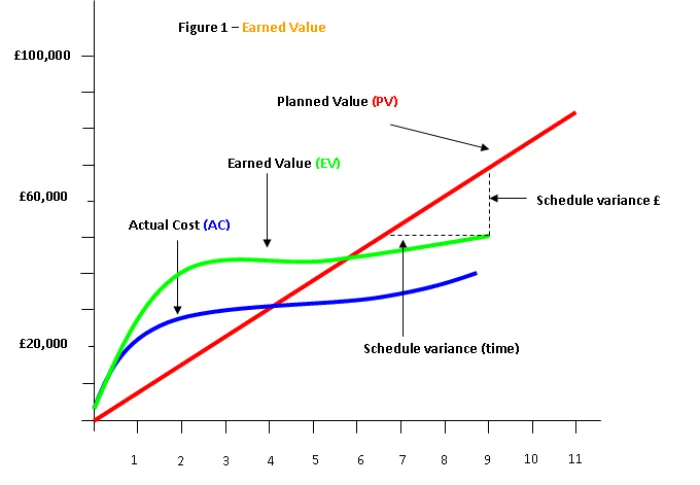
Earned Value as a means of tracking project progress is widely used on many software projects. It aims to give a clear picture of the status of a project in terms of cost and schedule. Earned Value is another tool in the Project Manager’s toolset.
This article describes what Earned Value (EV) is and the basics steps to follow when applying EV on a project.
Table of contents
EV is a project management tracking technique for reporting the status of a project in terms of schedule and budget to answer the following questions:
The aim of this technique is to provide a quick understanding of the project status for stakeholders.
To use EV, the project is broken down into a number of partially ordered work units to be completed. Each work unit is assigned a planned budget (resource level) and schedule (when to happen). As the project progresses the status of each work unit is monitored as follows:
Note, partially completed work units are not always counted towards completed progress. The objective of EV is to be clear on the current project status. However, in some cases once a work unit is started 50% value is automatically earned with the remaining 50% added on completion.
In theory, at anytime during the project lifecycle, EV can be applied to determine project status as over/under budget and over/under schedule.

Using earned value, the project status is expressed in the following terms:
These are calculated using the following:
Therefore:
For all work units determine a common earned value unit and assign a value to each work unit. The unit of measurement is arbitrary (dollars, man-days…). The following table shows an initial plan of the work units and the value associated with each.
| WU1 | WU2 | WU3 | WU4 | WU5 | WU6 | WU7 | WU8 | Total | |
| Planned Value | 10 | 15 | 8 | 12 | 6 | 8 | 9 | 10 | 78 |
As the project progresses, value is earned for each work unit completed in the same way as it was planned. The difference from planned and actual is recorded and referred to as the schedule variance. For each completed work unit the full value is earned.
| WU1 | WU2 | WU3 | WU4 | WU5 | WU6 | WU7 | WU8 | Total | |
| Planned Value | 10 | 15 | 8 | 12 | 6 | 8 | 9 | 10 | 78 |
| Earned Value | 10 | 15 | 8 | 12 | – | 8 | 9 | – | 62 |
| Schedule Variance | 0 | 0 | 0 | 0 | -6 | 0 | 0 | -10 | -16 |
For this case work units 5 & 8 are not completed and therefore earn no value for this period.
For each work unit completed calculate the actual cost expended to complete and compare with the planned cost.
| WU1 | WU2 | WU3 | WU4 | WU5 | WU6 | WU7 | WU8 | Total | |
| Earned Value | 10 | 15 | 8 | 12 | – | 8 | 9 | – | 62 |
| Actual Cost | 12 | 18 | 8 | 10 | – | 14 | 12 | – | 73 |
| Cost Variance | -2 | -3 | 0 | +2 | 0 | -6 | -3 | 0 | -11 |
Negative variance indicates more was spent than planned. Work unit 5 & 8 have no cost as they are not completed and therefore have not earned any value yet and cannot be taken into consideration.
BCWS = 78
ACWP = 73
BCWP = 62
Cost variance = 62 – 73 = -11
Schedule variance = 62 – 78 = -16
CPI = 62/73 = 0.84
SPI = 62/78 = 0.79
This project is currently behind schedule by 21% and over-budget by 16%!
It is important to note that earned value relies on the accuracy of initial estimates. However, as is the case with any software development, high accuracy planning is not possible in the early stages of any project. Software projects do not have a predictive lifecycle and this must be recognised during the planning and development processes.
Earned value therefore should not be used as an absolute measure, particularly during the early stages of a project. However, through a process of re-estimation during the project lifecycle, greater accuracy of estimates for project completion will be possible and therefore earned value will yield more accurate results.
Liemur provides Software Development Services within UK and with its nearshore branch in Budapest.
If you like this article, what about tweeting it or recommending it?
The diagram used to illustrate this article is the © Copyright all rights reserved March Limited.